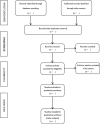The relationship between the expression of soluble programmed cell death-1 and cancer pain: A protocol for systematic review and meta analysis
- PMID: 33907102
- PMCID: PMC8084006
- DOI: 10.1097/MD.0000000000025555
The relationship between the expression of soluble programmed cell death-1 and cancer pain: A protocol for systematic review and meta analysis
Abstract
Background: The immune checkpoint programmed cell death-1 (PD-1) plays a critical role in immune regulation. Recent studies have demonstrated functional PD-1 expression in peripheral sensory neurons, which contributes to neuronal excitability, pain, and opioid analgesia. However, the relationship between the expression of soluble programmed cell death-1(sPD-1) and cancer pain is controversial. The purpose of this study was to evaluate the relationship between sPD-1 expression level and cancer pain through meta-analysis.
Methods: Studies were selected from Pubmed, Web of science, Embase, Google Scholar, and Chinese National Knowledge Infrastructure, and the Chinese Biomedical Literature Database based on inclusion and exclusion criteria. The standard mean difference (SMD) and 95% confidence interval (CI) were calculated using the random-effect model or fixed-effect model to assess the association between sPD-1 expression level and cancer pain. All analyses were performed with the Stata 14 software.
Results: This review will be disseminated in print by peer-review.
Conclusion: The results of this study will help us to determine whether the expression level of sPD-1 is related to cancer pain.
Ethics and dissemination: The private information from individuals will not be published. This systematic review also should not endanger participant rights. Ethical approval is not available. The results may be published in a peer-reviewed journal or disseminated in relevant conferences.
Osf registration number: DOI 10.17605/OSF.IO/WDPUY.
Copyright © 2021 the Author(s). Published by Wolters Kluwer Health, Inc.
Conflict of interest statement
The authors have no conflicts of interest to disclose.
Similar articles
-
Expression and significance of PD-1 and PD-L1 in patients with recurrent spontaneous abortion: A protocol for systematic review and meta-analysis.Medicine (Baltimore). 2021 Apr 9;100(14):e25444. doi: 10.1097/MD.0000000000025444. Medicine (Baltimore). 2021. PMID: 33832149 Free PMC article.
-
PD-L1 expression on peripheral T-cells and association with coronary heart disease patients: A protocol for systematic reviews and meta-analysis.Medicine (Baltimore). 2021 Mar 26;100(12):e25157. doi: 10.1097/MD.0000000000025157. Medicine (Baltimore). 2021. PMID: 33761687 Free PMC article.
-
Identification of potential biomarkers of long non-coding RNAs in neuropathic pain using bioinformatic analysis: A protocol for systematic review and meta-analysis.Medicine (Baltimore). 2021 Mar 26;100(12):e25147. doi: 10.1097/MD.0000000000025147. Medicine (Baltimore). 2021. PMID: 33761683 Free PMC article.
-
The value of microRNA-21 as a biomarker for the prognosis of lung cancer: A protocol for systematic review and meta-analysis.Medicine (Baltimore). 2020 Aug 14;99(33):e21483. doi: 10.1097/MD.0000000000021483. Medicine (Baltimore). 2020. PMID: 32871993 Free PMC article.
-
Prognostic value of long noncoding RNA urothelial carcinoma-associated 1 in esophageal carcinoma: A protocol for meta-analysis, TCGA data and bioinformatics analysis.Medicine (Baltimore). 2021 Apr 23;100(16):e25452. doi: 10.1097/MD.0000000000025452. Medicine (Baltimore). 2021. PMID: 33879677 Free PMC article.
References
-
- Keenan A, Keithley JK. Integrative review: effects of music on cancer pain in adults. Oncol Nurs Forum 2015;42:E368–75. - PubMed
MeSH terms
Substances
Grants and funding
LinkOut - more resources
Full Text Sources
Other Literature Sources
Medical


